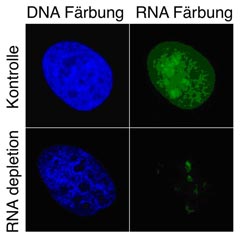RNA unpackages the genome and makes it accessible for gene expression

Microscopic picture displaying the distribution of DNA and RNA in human cells: Cellular DNA (blue) and RNA (green) were stained with specific dyes and visualized by fluorescence microscopy. In control cells containing RNA, the DNA is distributed homogenously within the cell nucleus. After specific RNA depletion (lower panel) the DNA aggregates into compact and inactive higher order structures of chromatin.<br><br>Image: University of Regensburg<br>
The genome encoding for all information to build an entire organism is made of DNA. This molecule is a very thin thread of about 2 m in length. The DNA has to fit into a cell nucleus with a diameter that is 100.000 times smaller than the length of the DNA. In order to stow and to protect the fragile DNA molecule inside, it is wrapped around molecular spools consisting of proteins.
About 30 millions of such spools, arranged like pearls on a string, are required to package the DNA molecule. The pearls on a string undergo further coiling and compacting to safely store DNA that is called chromatin in its packaged form. However, for cell function and daily use the DNA information of specific genomic regions have to be rendered accessible. Therefore active mechanisms must have evolved to unpackage the genome and allow the readout of the underlying genetic information.
Researchers belonging to the groups of the biochemist Gernot Längst from the University of Regensburg and Axel Imhof, a molecular biologist at the LMU in Munich, could now show that small RNA molecules regulate the accessibility and structure of the DNA in chromatin. They identified and characterized snoRNAs (a specific class of RNA molecules) as key regulators of chromatin organisation. In combination with an RNA and chromatin binding protein (the adapterprotein Df31) the RNA binds to specific regions of the genome. This complex interferes with the regular packaging of chromatin and locally decondenses this structure, thereby allowing the readout of the genetic information.
The results were published in „Molecular Cell“ ((DOI:10.1016/j.molcel.2012.08.021).
http://www.cell.com/molecular-cell/abstract/S1097-2765%2812%2900739-3?switch=standard
Press Contact:
Prof. Dr. Gernot Längst
University of Regensburg
Biochemistry III
phone +49 941 943-2849
gernot.laengst@vkl.uni-regensburg.de
Media Contact
More Information:
http://www.uni-regensburg.deAll latest news from the category: Life Sciences and Chemistry
Articles and reports from the Life Sciences and chemistry area deal with applied and basic research into modern biology, chemistry and human medicine.
Valuable information can be found on a range of life sciences fields including bacteriology, biochemistry, bionics, bioinformatics, biophysics, biotechnology, genetics, geobotany, human biology, marine biology, microbiology, molecular biology, cellular biology, zoology, bioinorganic chemistry, microchemistry and environmental chemistry.
Newest articles

Silicon Carbide Innovation Alliance to drive industrial-scale semiconductor work
Known for its ability to withstand extreme environments and high voltages, silicon carbide (SiC) is a semiconducting material made up of silicon and carbon atoms arranged into crystals that is…

New SPECT/CT technique shows impressive biomarker identification
…offers increased access for prostate cancer patients. A novel SPECT/CT acquisition method can accurately detect radiopharmaceutical biodistribution in a convenient manner for prostate cancer patients, opening the door for more…

How 3D printers can give robots a soft touch
Soft skin coverings and touch sensors have emerged as a promising feature for robots that are both safer and more intuitive for human interaction, but they are expensive and difficult…





















